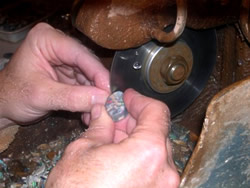How to Cut and Polish Opal
FAQ: How is opal cutting done? How do I cut rough opal? Where can I learn about cutting opals? How is opal polishing done? How can I polish an opal?
Opal cutting and polishing is a very specialised skill. Rough opal is normally purchased from the opal miners as ‘parcels’ (Bulk quantities of opal in its rough state). Potential buyers sort through the parcels and try to predict the value of stones which can be produced from the rough material.

However there is never any guarantee, as opal cutting can produce very unpredictable outcomes. Once the opal cutter has sorted through the parcel and decided which pieces are worth cutting, a diamond saw is used to cut the rough opal into ‘ rubs’ (opal in the rough shape of a stone). During this process, any excess material, cracks and potch (colourless opal) is cut off, and the piece of opal is cut into a basic stone shape.

Probably the most basic concept which any opal cutter needs is to keep the stone as large as possible, i.e. minimising waste and maximising the end size of the stone.
Each moment of cutting reduces the size of the stone, so control must be exercised. The second basic concept is that opal can be ‘burned’ or may even crack if subjected to extreme temperatures. For this reason, water must always be used when cutting opal to avoid overheating due to friction. ‘Burning’ a stone during polishing results in small pits forming on the surface thereby ruining the smooth surface and polish.



After the stone has been cut on the saw by hand, the opal cutter will then normally place the stones on ‘dop sticks’, consisting of nails or lengths of wood dowling, using heated wax to adhere the stone to the end of the stick. This allows a greater degree of control of the stone on the cutting wheel, especially when the stone is small. The wax is softened on a burner to permit the fixing of the stone, which is first adhered with the face of the stone pointing upwards. The face of the stone is decided by the opal cutter, considering which side has the best colour, and the best shape for the stone.
The opal cutter then uses a series of diamond grinding wheels (coarse to fine) to shape and perfect the stone. Importance is placed on removing imperfections, such as sand spots, and removing saw marks and rough spots from previous stages. The face of the stone is shaped into a cabochon (dome shape) and the shape is decided depending on the stone (normally oval). Again, maximising the size of the stone is an important consideration.
The final stage for the face is polishing. Serium Oxide is used as a polishing agent on a felt wheel with water to give the stone a beautiful polish. If the cutter is happy with the shape, and the absence of scratches, grinding marks or imperfections, he removes the stone and sticks it back on the wax with the back facing up.
The back of the stone is cut on the same set of grinding wheels, this time producing a flat bottom for the stone, and an edge which tapers up to the ‘girdle’. The shaping of the girdle is an important and difficult part of cutting, and refers to the point on the side of the stone where the two top & bottom edges meet. This edge is used by jewellers to set the stone underneath the gold, to provide a secure setting.
Boulder opal can be significantly more difficult to work. The opal forms in tiny cavities in the ironstone, therefore the seams of opal that run through the boulder can be of very excellent quality but are very thin veins from .25mm to 20 mm thick. The ironstone is generally left as backing to support the stone.
Occasionally a thick vein is deposited allowing the cutter to cut the opal in cabochon, however frequently the veins are thin and wavy, so the cutter is challenged to cut and polish the piece following the deposition of the opal, resulting in an undulating or baroque surface. Stones are generally cut into freeform shapes, which is dictated by the opal deposition and flaws within the piece.
Ironstone is also significantly harder than opal, (opal is only as hard as glass) which provides another challenge for the opal cutter. Opal will grind much quicker than ironstone, so extra care must be taken when polishing a surface comprised of both materials.
So, now you know how to cut opal! Well, not exactly… this is only a very rough guide, and it takes a lot of practice to cut opal correctly. We recommend that learners get hold of some cheaper rough material to begin with, and to get a feel for the stone. Cutting and polishing opal is a great skill, and it’s also very rewarding to uncover such beautiful colour!
Sources:


